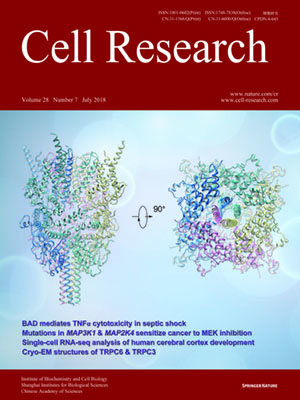
Volume 28, No 7, Jul 2018
ISSN: 1001-0602
EISSN: 1748-7838 2018
impact factor 17.848*
(Clarivate Analytics, 2019)
Volume 28 Issue 7, July 2018: 746-755
ORIGINAL ARTICLES
Structure of the receptor-activated human TRPC6 and TRPC3 ion channels
Qinglin Tang 1, Wenjun Guo 1, Li Zheng 2, Jing-Xiang Wu 1,3, Meng Liu 2 , Xindi Zhou 2, Xiaolin Zhang 2 and Lei Chen 1,3
1 State Key Laboratory of Membrane Biology, Institute of Molecular Medicine, Beijing Key Laboratory of Cardiometabolic Molecular Medicine, Peking University, 100871 Beijing,
China; 2Dizal Pharmaceutical Company, Jiangsu, China and 3
Peking-Tsinghua Center for Life Sciences, Peking University, 100871 Beijing, China
Correspondence: Correspondence: Xiaolin Zhang (Xiaolin.Zhang@dizalpharma.com) or Lei Chen (chenlei2016@pku.edu.cn)These authors contributed equally: Qinglin Tang, Wenjun Guo.
TRPC6 and TRPC3 are receptor-activated nonselective cation channels that belong to the family of canonical transient receptor potential (TRPC) channels. They are activated by diacylglycerol, a lipid second messenger. TRPC6 and TRPC3 are involved in many physiological processes and implicated in human genetic diseases. Here we present the structure of human TRPC6 homotetramer in complex with a newly identified high-affinity inhibitor BTDM solved by single-particle cryo-electron microscopy to 3.8 Å resolution. We also present the structure of human TRPC3 at 4.4 Å resolution. These structures show two-layer architectures in which the bell-shaped cytosolic layer holds the transmembrane layer. Extensive inter-subunit interactions of cytosolic domains, including the N-terminal ankyrin repeats and the C-terminal coiled-coil, contribute to the tetramer assembly. The high-affinity inhibitor BTDM wedges between the S5-S6 pore domain and voltage sensor-like domain to inhibit channel opening. Our structures uncover the molecular architecture of TRPC channels and provide a structural basis for understanding the mechanism of these channels.
doi:10.1038/s41422-018-0038-2
FULL TEXT | PDF
Browse 1668


